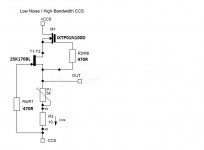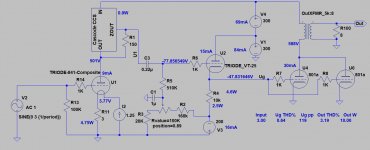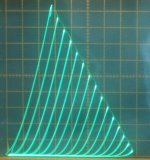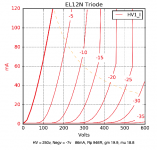Time to build a cathode follower, then. Ale's solution is of course something I'll try - I haven't referred to it yet because I already have one of his pcbs, and I just need to dig it out and find out if it's the most recent version.
Then it will be choosing a tube for the cathode follower and working out a circuit. Any suggestions here welcome.
Hanze's suggestion is interesting too. Will have to look at that. I'm using either an EL12n or a 300b output stage so a circuit that would suit either would be good.
Then it will be choosing a tube for the cathode follower and working out a circuit. Any suggestions here welcome.
Hanze's suggestion is interesting too. Will have to look at that. I'm using either an EL12n or a 300b output stage so a circuit that would suit either would be good.
Hi Andy
Look for any high-gm pentode (triode strapped) and will work well. Examples: D3a, E180F, E280F, 6z52p, 6z51p, 6z49p, and the list goes on. Make sure you add the grid stopper and decouple anode with a good film capacitor between anode and cathode ground point. No need to add a tail CCS, you can get one working well with a resistor.
Ale
Look for any high-gm pentode (triode strapped) and will work well. Examples: D3a, E180F, E280F, 6z52p, 6z51p, 6z49p, and the list goes on. Make sure you add the grid stopper and decouple anode with a good film capacitor between anode and cathode ground point. No need to add a tail CCS, you can get one working well with a resistor.
Ale
Andy, I have tried for 26:
-OPT 4.5:1
-Lundahl 1660 as anode choke
-Ale gyrator
No one satisfied my taste, now I'm using CCS as load as attached schematic with high gain & natural sound. Grid stoppers carbon.
What are you using as volume control?
Other important thing is to match well the input/output impedance, Miller efect, input capacitance, etc.
Attachments
Last edited:
Andy,
You have perhaps seen this CF from Thorsten already, but in case not:
Audio Asylum Thread Printer
Audio Asylum Thread Printer
You have perhaps seen this CF from Thorsten already, but in case not:
Audio Asylum Thread Printer
Audio Asylum Thread Printer
Last edited:
Then it will be choosing a tube for the cathode follower and working out a circuit. Any suggestions here welcome.
Try such 10Y CF, using in my 801a PSE.
Attachments
No, my daily amplifier (now Bill Evans play on piano) is CCS loaded D3a, FET SF -source follower-, 300B 5k:8 (10W).
This 801a PSE monster lay in my workroom (breadboarded, about 2 square meter, weight with PSU 15-20kg) waiting for boxing ... for at least two years ... but singing wonderfully.
I'm listening it alternately in CF or SF configuration ... for me SF is better: more accurate tight deep, faster transients ... no wonder, the SF output impedance is only few Ohm till few hundred KHz.
This 801a PSE monster lay in my workroom (breadboarded, about 2 square meter, weight with PSU 15-20kg) waiting for boxing ... for at least two years ... but singing wonderfully.
I'm listening it alternately in CF or SF configuration ... for me SF is better: more accurate tight deep, faster transients ... no wonder, the SF output impedance is only few Ohm till few hundred KHz.
Last edited:
Any triode curves around for the EL12N? I can't find any on the WWW.
I'm wondering if the driver is providing some harmonic compensation for the output tube here. The 4P1L that I have curve traced are remarkably linear. Maybe the 01A is providing some counter distortion that one needs to be aware of.
4P1L triode curves:
I'm wondering if the driver is providing some harmonic compensation for the output tube here. The 4P1L that I have curve traced are remarkably linear. Maybe the 01A is providing some counter distortion that one needs to be aware of.
4P1L triode curves:
Attachments
Last edited:
The curves were posted earlier in the thread. Here they are again, and thanks once more for creating them.
It's an interesting question how the driver and output tube are inter-reacting. I don't have measuring equipment to give you data, unfortunately, but what I can say is that I've built very many amps and preamps with 01A and 4P1L (plus 26, 10Y etc) over 12 years and my listening impressions are pretty constant with regard to the sound of each of these DHTs.
The 01A is my favourite for tonality, alongside the 10Y - both thoriated. I have little to criticise with either, and I'd describe the tonality as neutral. The 26 is a warmer sound with a full midrange tone which many call "euphonic". The 4P1L is clean and clear but with a slight treble hardness and what I would call a slightly "disembodied" midrange. In this respect it's at the opposite end of the 26.
These listening impressions are of course subjective, however they have been done over 12 years of constant daily listening. In addition I audition very carefully for tonality - I'm a professional musician who is very familiar indeed with the acoustic timbre of orchestral instruments plus voices, jazz drum kits etc., and I have some very carefully chosen orchestral, opera and jazz/rock excerpts which highlight the different tonalities I am assessing. So some care has gone into the auditioning process.
So with regard to the 4P1L, the curves do indeed look nice, but they may not tell the whole story. In my case all the choices of tubes are based on listening, which is an individual process and different for each listener. I used the 4P1L for many years when I considered it "good enough" but I keep coming back to what I consider better DHTs like the 01A, 10Y, 46, 300b, 2a3 and some others (don't have any 45, 47).
In the case of the EL12n, which is one of the very few indirectly heated tubes I've used in the last 12 years, I'd say the tonality was substantially neutral trending very slightly towards bright in the treble and thinner in the midrange. Since this is what I hear with the 4P1L I'd call it a bad pairing, unusable in fact. The EL12n sounds fine with the 10Y, that's a wrap. With the 01A the tonality is good, but it needs better drive into the output stage, hence this thread. I'm using the EL12n because the mu of 18 gives me the option to use DHT drivers in a 2-stage amp.
Sorry if this is rather long-winded, and the question of interaction between driver and output tube is of great interest. Thanks for posting.
It's an interesting question how the driver and output tube are inter-reacting. I don't have measuring equipment to give you data, unfortunately, but what I can say is that I've built very many amps and preamps with 01A and 4P1L (plus 26, 10Y etc) over 12 years and my listening impressions are pretty constant with regard to the sound of each of these DHTs.
The 01A is my favourite for tonality, alongside the 10Y - both thoriated. I have little to criticise with either, and I'd describe the tonality as neutral. The 26 is a warmer sound with a full midrange tone which many call "euphonic". The 4P1L is clean and clear but with a slight treble hardness and what I would call a slightly "disembodied" midrange. In this respect it's at the opposite end of the 26.
These listening impressions are of course subjective, however they have been done over 12 years of constant daily listening. In addition I audition very carefully for tonality - I'm a professional musician who is very familiar indeed with the acoustic timbre of orchestral instruments plus voices, jazz drum kits etc., and I have some very carefully chosen orchestral, opera and jazz/rock excerpts which highlight the different tonalities I am assessing. So some care has gone into the auditioning process.
So with regard to the 4P1L, the curves do indeed look nice, but they may not tell the whole story. In my case all the choices of tubes are based on listening, which is an individual process and different for each listener. I used the 4P1L for many years when I considered it "good enough" but I keep coming back to what I consider better DHTs like the 01A, 10Y, 46, 300b, 2a3 and some others (don't have any 45, 47).
In the case of the EL12n, which is one of the very few indirectly heated tubes I've used in the last 12 years, I'd say the tonality was substantially neutral trending very slightly towards bright in the treble and thinner in the midrange. Since this is what I hear with the 4P1L I'd call it a bad pairing, unusable in fact. The EL12n sounds fine with the 10Y, that's a wrap. With the 01A the tonality is good, but it needs better drive into the output stage, hence this thread. I'm using the EL12n because the mu of 18 gives me the option to use DHT drivers in a 2-stage amp.
Sorry if this is rather long-winded, and the question of interaction between driver and output tube is of great interest. Thanks for posting.
Attachments
Last edited:
Interesting. The EL12N appears to have near constant mu at constant current, but some "roll-over" in the curves versus plate V. This would produce some 2nd harmonic with an actual load line.
The 01A looks quite linear, nearly flat mu. The 26 has the "roll-over" in its curves with more mu variation.
Tubes don't generally have any variation in freq. response across the audio range unless there is a slew rate problem driving it, particularly with triodes. However, the amplitude of sound signals typically become less at higher frequencies, so the tube effectively becomes more linear for them.
Maybe you are hearing microphonics from the 4P1L, they seem to be known for that. Might try 12P17L to see if that fixes the problem.
The 01A looks quite linear, nearly flat mu. The 26 has the "roll-over" in its curves with more mu variation.
Tubes don't generally have any variation in freq. response across the audio range unless there is a slew rate problem driving it, particularly with triodes. However, the amplitude of sound signals typically become less at higher frequencies, so the tube effectively becomes more linear for them.
Maybe you are hearing microphonics from the 4P1L, they seem to be known for that. Might try 12P17L to see if that fixes the problem.
Last edited:
I don't know if it's a question of microphonics - I have no obvious problems with microphonics and my chassis is pretty massive 4mm aluminium. Both myself and other listeners have remarked that a 4P1L driving another 4P1L is not a good sound - it exaggerates the hardness and becomes rather unpleasant. So I believe there's something inherent in the tube itself, though others use it happily. I crave smoothness since I listen to a lot of orchestral and opera and acid violins are a total no-go. So with regret I've put the 4P1L to one side. Shame since I have well over 100 of them.
4P1L doesn't have extreme gm, but seeing as the datasheet says its used for VHF oscillators, maybe a grid stopper would help?
Maybe for grid 2 also.
Maybe for grid 2 also.
I've always used 390R grid stoppers in G1, G2 and G3. A+G2+G3 are connected. Don't know if larger values would help. The 4P1L isn't on my radar at present - I've never been 100% happy with it, and really only used it in PSE outputs in filament bias. Plenty of threads here from others who use it, though.
The curves were posted earlier in the thread. Here they are again, and thanks once more for creating them.
Where? Was the post deleted?
- Home
- Amplifiers
- Tubes / Valves
- How to get more drive out of an 01A DHT?




